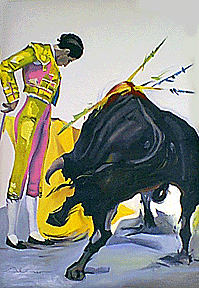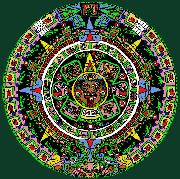Earlier, following the matadors and the banderillos,
have come the picadors on padded horses, lances pointed skyward. As they
draw close to the barrera, they all tip their hats to the
dignitaries, then slide behind the shoulder-high protective barricades
that shield them off from the arena itself.
The matadors, their Trajes de Luces glistening
in the sun, confer with their managers while swinging their capes to
test the wind. The banderilleros, who will be the first to test
the bull, move to the opposite side of the ring and along with the
senior matador, await the first bull. When the beast finally enters, the
capeadores wave their capes at him, trying to incite a charge.
But they must never "pass" the bull. That feat is reserved
only for matador. Having watched how the bull charges, and whether he
hooks left or right, the matador advances into the ring. Now he must
face the bull alone. The corrida has begun.
Bullfighting isn’t only a contest between man
and bull. It’s the epitome of a more universal struggle–man's
conquest of his own fears.
The object of the sport is for the matador to
conquer and kill the bull with a swift clean kill by placing a sword in
a coin-sized area between the bull's shoulders. For this reason, it
takes extreme courage and many hours of training to become a matador. In
reality, bullfighting cripples one out of four matadors during their
careers. One out of ten die.
Bullfighting is a type of dramatic dance with
death. As he would in dancing, Mendez must control his movements —
maintaining the rhythm, not of music, but of danger. On stage, a
faux-pas means an interruption of artistic flow. In the bullfighting
arena, a mistake by the matador could mean death.
During the eight centuries of the Spanish War
of the Reconquest (711-1492 A.D.), the knights, Moors and Christians,
weary of killing one another, would occasionally hunt wildlife to avoid
boredom. While deer were easy prey and a cornered bear or boar would
usually put up a fight, it was the wild Iberian bull that presented a
challenge for these valiant knights. When provoked, it would rather die
fighting than flee. At some point, a nobleman captured several bulls and
recreated the fight in the village. Thus the sport of bullfighting was
born.
 The
first historic bullfight, or corrida de toros, took place in
Vera, Logro
The
first historic bullfight, or corrida de toros, took place in
Vera, Logro
o,
Spain, in 1133, in honor of the coronation of King Alfonso VIII. From
that point on, kings organized corridas to commemorate important events
and to entertain their guests. After the Spanish War of the Reconquest,
the celebration of corridas expanded throughout Spain.
During the reign of King Philip II, Pope Pius
V, appalled at the unconscionable carnage of the bullfights, forbade the
practice of the corridas. The people, however, ignored the papal decree
and continued to relish the fiesta brava, forcing Pope Gregory VIII to
recant the decree.
Bullfighting was then transformed and
democratized. The squire, on foot, became the master of the arena,
today's matador, and the knight, on horseback, became today’s picador.
Matadors such as Rafael Molina, Belmonte and
Manolete, introduced changes that converted what once was a primitive
and cruel encounter into a skillful art form, practiced today in the
bullfighting arenas of Spain, France, Portugal, and in the Latin
American republics of Mexico, Colombia, Peru, Venezuela, Ecuador,
Guatemala, and Panama.
Bullfighting–known in Mexico as Fiesta
Brava, made its debut in Mexico City, on June 26th 1526, with the
first bullfight in honor of Hernan Comes, on his return from Las
Hibueras which is now Honduras. Throughout the three centuries that
Spain ruled Mexico, bullfights were held regularly to honor city and
religious celebrations.
Only Spain holds more bullfights annually than
Mexico. And Tlaxcala has been the center of Mexican bullfighting since
Cortes’ army stopped to rest there on their way to conquer the Aztecs
in Tenochtitlan.
In every corida de toros, matadors kill
four to six bulls. Watching one isn’t for the faint hearted. In an
average afternoon session, three matadors each fight two bulls. The
fight begins as the bull is released into the ring and the torero or
bullfighter’s assistant takes a few passes of the bull with his cape,
to gauge the reactions of the bull. Then picadors riding horses enter
the ring and draw the first blood then exit the ring.
The traditional cape work with the bull then
follows, with each pass of the cape being accompanied by a hearty cry of
"Ole!" from the crowd. The matador kills the bull in a
ritualistic manner by thrusting a lethal blow of the sword deep into the
bulls back. A judge scores the killing, and if not done perfectly, it
could bring shame upon the matador.
The trophies awarded to the matador amount to
nothing more than the people's momentary show of emotion and perhaps the
tail of the bull. It’s not unusual for a matador, who may have only
performed one artful move during the corida, to be the true winner of
the day. Those matadors just beginning to fight, called novilleros, fight
not in a corrida but in a novillada with novillos (young
bulls).
The empressario or promoter of the
corida pays at least $2,500 for each of six bulls–some cost as much as
$10,000. Each corida has three sessions with two bullfights per session.
Smaller towns have coridas with just four bulls in two sessions.
Regardless of what opinion people may have of
it, bullfighting is a sport and, as such, requires skill and endurance–but
most of all courage. And just as with the NFL or the NBA, it’s players
are trained–both man and bull–for top performance. But the bulls are
also bred to provide excitement and drama in the ring.
Without a fine looking, strong and courageous
bull, however skilled and determined the bullfighter, it will not be a
fine performance. That’s why the breeding of fighting bulls is very
important.
Today, the State of Tlaxcala has the largest
number of bull breeding ranches or ganaderias–a total of 40,
followed by the States of Guanajuato and Jalisco. The premier ranch is
Ganaderia La Laguna de Terrenate, founded in 1908 by Don Romareo
Gonzalez, with cows from Tepeyahualco and a breeding bull from Ibarra.
It has had more winners at the Plaza Mexico in Mexico City–23 to date–than
any other breeding ranch in Mexico.
Mendez and his father own two breeding ranches–the
larger one, Ganaderia Garcia, located in Tetla, Tlaxcala, is used only
for breeding while the second and smaller one, Rancho Santa Anita, in
Santa Anita, Tlaxcala, is strictly for "feed and seed," or
selling and training the three and four-year-old bulls for the ring.
"We fight the cows to see if they have
style," said Mendez. "Cows with good style are bred. Those
without are killed and sold for meat."
The largest bullring in Mexico, seating 60,000,
is the Plaza Mexico in Mexico City. The season here lasts from November
to March. Novillades, featuring novice matadors and young bulls, are
held from June to October.
Tlaxcala holds its coridas on All Saints Day on
November 1 and during its annual fair in the same month.
Huamantla, also in the State of Tlaxcala and
with a great tradition for bullfighting
is home to the only Bullfighting Museum in the
state. Its bullring "La Taurina," built by a group of fans and
inaugurated on August 15th 1918, holds 5,500 people.
Tourists go to the covered and air-conditioned
ring in Cancun, the only one of its kind, on Wednesday afternoons when
the cruise ships are in. More than 90 per cent of the spectators are
American and Canadian. Each tourist pays a ticket price of about $29
(US) for a two-hour show that includes dances, rodeo, greased pig chases
and finally a bullfight. When the arena first opened, the show included
four kills. However, the ring’s management soon learned that audiences
disappeared quickly after being startled by the cruelty for which many
weren’t prepared.

